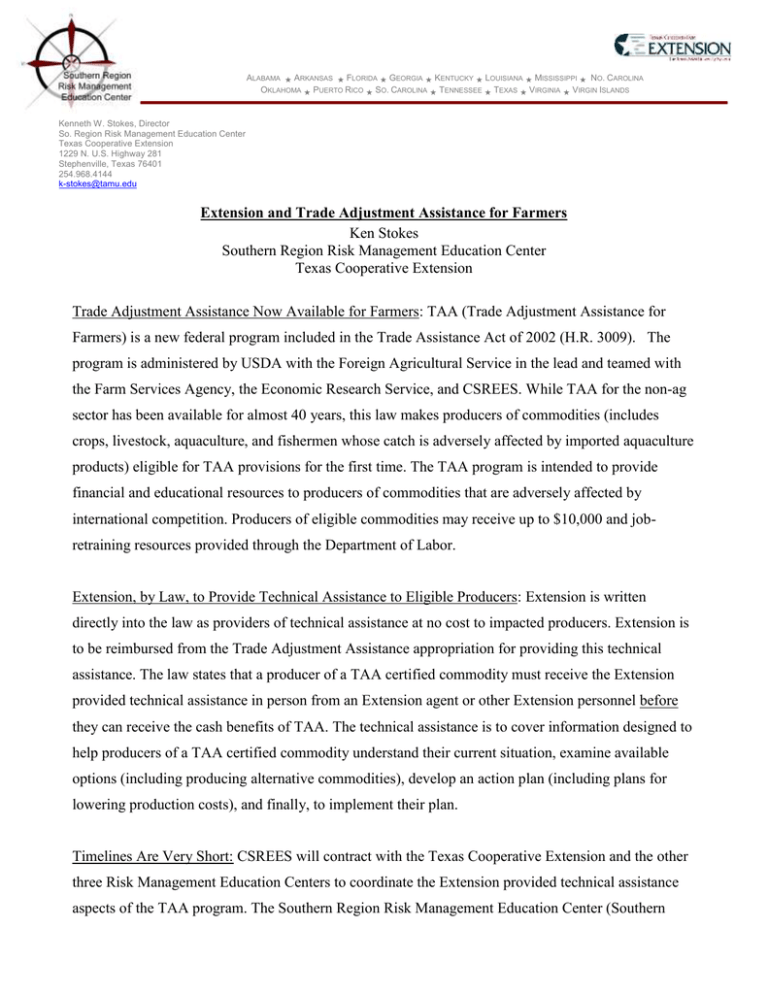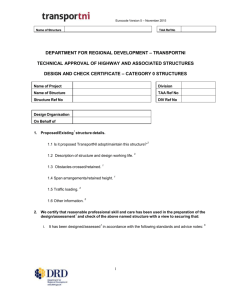A F G
advertisement

ALABAMA ARKANSAS FLORIDA GEORGIA KENTUCKY LOUISIANA MISSISSIPPI NO. CAROLINA OKLAHOMA PUERTO RICO SO. CAROLINA TENNESSEE TEXAS VIRGINIA VIRGIN ISLANDS Kenneth W. Stokes, Director So. Region Risk Management Education Center Texas Cooperative Extension 1229 N. U.S. Highway 281 Stephenville, Texas 76401 254.968.4144 k-stokes@tamu.edu Extension and Trade Adjustment Assistance for Farmers Ken Stokes Southern Region Risk Management Education Center Texas Cooperative Extension Trade Adjustment Assistance Now Available for Farmers: TAA (Trade Adjustment Assistance for Farmers) is a new federal program included in the Trade Assistance Act of 2002 (H.R. 3009). The program is administered by USDA with the Foreign Agricultural Service in the lead and teamed with the Farm Services Agency, the Economic Research Service, and CSREES. While TAA for the non-ag sector has been available for almost 40 years, this law makes producers of commodities (includes crops, livestock, aquaculture, and fishermen whose catch is adversely affected by imported aquaculture products) eligible for TAA provisions for the first time. The TAA program is intended to provide financial and educational resources to producers of commodities that are adversely affected by international competition. Producers of eligible commodities may receive up to $10,000 and jobretraining resources provided through the Department of Labor. Extension, by Law, to Provide Technical Assistance to Eligible Producers: Extension is written directly into the law as providers of technical assistance at no cost to impacted producers. Extension is to be reimbursed from the Trade Adjustment Assistance appropriation for providing this technical assistance. The law states that a producer of a TAA certified commodity must receive the Extension provided technical assistance in person from an Extension agent or other Extension personnel before they can receive the cash benefits of TAA. The technical assistance is to cover information designed to help producers of a TAA certified commodity understand their current situation, examine available options (including producing alternative commodities), develop an action plan (including plans for lowering production costs), and finally, to implement their plan. Timelines Are Very Short: CSREES will contract with the Texas Cooperative Extension and the other three Risk Management Education Centers to coordinate the Extension provided technical assistance aspects of the TAA program. The Southern Region Risk Management Education Center (Southern -2Center) will be responsible for subcontracting with the Extension Services in the 13 southern states to provide the required training to producers of certified commodities on a cost reimbursement basis. The timing provisions for this program are extremely short. How Might Extension’s Role in TAA Work? Technical Assistance/Curriculum Development— The four regional RME centers and the Digital Center (U of MN) are in the process of preparing a generic technical assistance package and will have it ready for Extension educators to use with eligible producers of a TAA certified commodity. In addition when a commodity is certified, the Southern Center will contract with a group of selected specialist to prepare a technical assistance package/curriculum specifically for producers of that commodity. It is planned that development of a particular curriculum/technical assistance package will be accomplished by one or more Extension Specialists in the involved states or other Extension personnel with specific expertise on the certified commodity. If there are no Extension personnel with commodity specific expertise, the Southern Center will work with the applicable state’s Extension TAA contact to find other suitable individuals to put together the curriculum. Since most commodities are produced in different geographical regions, it may be necessary to prepare several region specific versions of the curriculum. The curriculum/technical assistance package must include at minimum; information and training to help eligible producers understand their current situation, examine available options including producing alternative commodities or leaving agriculture, aquaculture or fishing, develop an action plan (including plans for lowering production costs), alternative commodity and marketing methods, job re-training opportunities (provided by the respective State Employment Agencies) and a listing of other governmental programs for which the grower may be eligible. Development Time will be Very Short: The completed curriculum must be reviewed and made available for delivery to producers within 45 days of the certification date. Given that, the first applications for salmon (AK, WA or OR ) and wild blueberries (MA) were accepted by USDA on September 15, 2003, Extension in the western states will be required to have technical assistance Extension programs serve people of all ages regardless of socioeconomic level, race, color, sex, religion, disability or national origin. The Texas A&M University System, U.S. Department of Agriculture and the County Commissioners Courts of Texas cooperating. -3available as early as October 25, 2003. In the South, we are expecting catfish and shrimp petitions to be accepted on October 1, 2003. Face to Face Technical Assistance: Since the law requires that a producer must meet directly with an Extension agent or other Extension personnel to receive the TAA technical assistance, technical assistance delivery will be conducted by County faculty/agents, Extension specialists, and/or departmental faculty. The costs for this activity will be reimbursed through a subcontract between Texas Cooperative Extension and the appropriate Extension organization. Once the curriculum/technical assistance package is developed, the current plan will be to hold training for the individuals who will conduct the technical assistance sessions. Conceptually, we are hoping to implement a per-producer-reached reimbursement fee that would be sufficient to cover all applicable technical assistance delivery costs but this has not been determined. One proposed rate schedule for each training session is $100 for the first five producers trained, $50 for the next five and $20 per producer for each additional producer trained over 10. It is the CSREES program manager’s hope that to the greatest extent possible, the money shall be directed into programs of the Extension personnel who actually deliver the information to growers and that it will fully cover all TAA associated costs. One-on-One or Workshops: Depending upon the number of growers involved, delivery methods will vary from single grower sessions to large numbers of growers at workshops conducted throughout the area where the certified crop is grown. Whatever delivery method is deemed most appropriate, the Extension System must be prepared to deliver the information to the growers no later than 90 days after the crop is certified. A producer cannot receive the benefits of the TAA program without documentation that the producer has “met” with someone from Extension to receive TAA technical assistance. The manner of producer technical assistance certification is being developed. A Day Late: The difficulties of working through a very complicated and politically sensitive program at the Federal level, has delayed adoption of the final program rule and made implementation wait until the very last moment. The Extension Risk Management Education Centers are just now receiving their authority to move ahead. This is a work in progress and we are hoping for the collaboration and meaningful involvement of Extension personnel across the South. Extension programs serve people of all ages regardless of socioeconomic level, race, color, sex, religion, disability or national origin. The Texas A&M University System, U.S. Department of Agriculture and the County Commissioners Courts of Texas cooperating.






